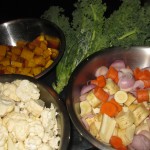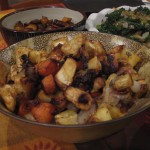When it comes to good health, food is the foundation. This time of year, it is essential that you invest in cooking up some good food for yourself and your family. It doesn’t take as much time as you might think. You’ve just got to decide you’re gonna do it.
That investment of time and good food pays off with better digestion which helps with better sleep which manifests as better health. As a bonus, half of tomorrows dinner is all set too!
Last night, I pulled out all the roast-able veggies I could find from my refrigerator. Carrots, Parsnips, Golden Beets, Shallots, Cauliflower, Winter Squash. These beauties had been patiently sitting in my fridge, just waiting for me to do something with them. I’m betting you’ve got some veggies hiding out in your refrigerator that would work for this as well.
I got out a sharp knife and a good cutting board and I spent 10 minutes chopping these veggies into evenly sized pieces. Cutting up veggies with a good knife can be a moving meditation if you let it. Its just you, the knife, the cutting board and the veggies. Very satisfying and relaxing.
After all the veggies are chopped, simply toss with olive oil and a pinch of salt, roll ’em out onto a roasting tray and off to the oven they go. You can use high heat, 400 degrees, or low heat 350, either way, just check up on them every 10 minutes, move them around. Once they are soft on the inside and a bit brown and crispy on the outside, you’re done.
Having leftover roasted veggies is better than money in the bank. Tomorrow night, you can toss them into a quinoa or rice pilaf, add them to some soup or make a Roasted Veggie Minestrone.
I’ll probably saute my roasted cauliflower with some curry powder and add some frozen peas to make my own easy version of Aloo Gobi, a yummy indian style cauliflower dish.
The moral of this story is plan on cooking once and eating twice. You’ll always end up with healthier food if you cook it yourself from beneficial ingredients, real food that is.
Leftovers are an important component of better health. If you missed it last week, click here for a great essay in the NY Times about the history of leftovers.



